What is brick | Size of bricks | Composition – Types of brick | Brick bond | Type of brick bond
What is brick
Bricks are the most common and oldest material used
in building construction which is made of clay. Which contains silica, alumina,
lime, ferric oxide alkali and other ingredients. It is much cheaper than other
materials.
A brick is the rectangular block obtained by the
moulding clay and then by drying and burning by this block.
Brick always arranged uniformly in shape and size.
They can be properly arranged and being light in nature they can be easily
handed.
Bricks are used for building up exterior and interior
wall partitions, piers, footing and other load bearing structures.
What is concrete compaction | Types of concrete compaction
Size of brick
| Brick size | Size in cm |
|---|---|
|
Standard or modular size of brick |
19 cm x 19 cm x 9 cm |
|
Nominal size of brick |
20 cm x 20 cm x 10 cm |
|
Traditional size of bricks |
23 cm x 11.4 cm x 7.6 cm |
Standard or modular size of brick is = 19 cm x 19 cm x 9 cm
Nominal size of brick is = 20 cm x 20 cm x 10 cm
Traditional size of bricks or field size of bricks
= 230 mm x 114 mm x 76 mm (9″ x 4 1/2″ x 3″)
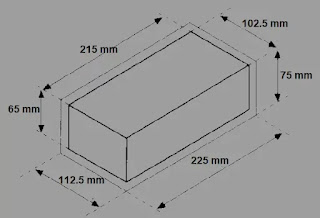 |
| Size of brick |
Number of bricks in 1 metre square volume = 500
bricks
Number of bricks 1 meter cube bricks masonry
= 500 bricks
Specific gravity of bricks = 2
Weight of brick is = 3 kg [ Properties of bricks]
Traditional size of bricks – In our country bricks are made in non-standardize size. This non-standardize size is called the traditional size of bricks.
Composition of brick
| Composition of bricks | Percentage of chemical composition of brick |
|---|---|
| Silica | 50% – 60% |
| Alumina | 20% to 30% |
| Lime | 4% to 6% |
| Magnesia | 1 % |
Silica
- A good brick clay contains 50% to 60% silica
in bricks.
- Silica prevents cracking, shrinking and
warping of brick clay.
- Silica impart durability and uniform shape and size to bricks.
- Excess amounts of silica destroy the cohesion
between particles and the bricks become brittle.
- As free sand, it is mechanically mixed with clay
and in combination it exists in chemical composition with alumina.
Alumina
- A good brick clay /earth contains 20% to 30%
of aluminium.
- Alumina is a cheap clay ingredient. It absorbs
water and imparts plasticity to the clay such that it can be moulded.
- In excess amount of Alumina in bricks it causes to
shrink, warp / crack in bricks on drying. and becomes too hard when burnt.
- Clay having high Alumina are found to be very
refractory.
Lime
- A brick clay contains 4% to 6% of lime. It provided
hardness to the bricks.
- Lime prevents shrinkage on drying.
- Silica in clay melts on burning and lime helps to
bind it.
- Excess amount of lime in bricks. it causes bricks
to melt hence bricks lose their shape.
Magnesia
- A small quantity of magnesia in bricks Earth.
Bricks contains 1 % of magnesia
- Excess amount of magnesia leads to decay of bricks.
Iron oxide
- A good brick Earth / clay contains 5% to 6% of iron
oxide.
- Iron oxide gives red colour in brick on burning.
When excess oxygen is available and dark brown or even black colour when oxygen
available is insufficient.
- Excess amount of the iron oxide makes bricks dark
black.
- Iron oxide improves impermeability and durability;
it also gives strength and hardness.
Other ingredient
Other ingredients of bricks such as potassium,
salt, alkali etc. are also mixed with brick clay in small quantities. Excess
amounts of Such ingredients decrease the strength and uniform shape of bricks. [Chain Surveying]
Types of brick
Heavy Duty bricks
As per name it is very Heavy duty bricks. These
bricks are used for very heavy Engineering Construction / Structure like
Bridges, Dams etc.
Those type of bricks have a compressive strength around 40N/mm2 to 45 N/mm2 or more. class 40 or class 45 are called heavy duty bricks.
The water absorption of heavy duty bricks less than
10% of its dry weight.
Perforated brick
Perforated bricks are also called hollow bricks.
Hollow bricks are very lighter in weight and the dimensions are the same as
nominal bricks.
This type of bricks have cylindrical holes whose
direction can be horizontally and vertically throughout the dimension.
Total 30% to 45% are material save for made up
hollow bricks, so that it requires less quantity of clay and easily burning and
drying.
In hollow bricks the main reason for providing the
hollow are heat transfer and heat insulation in a structure.
The compressive strength of hollow bricks is 7 N/mm2 .
Hollow bricks are available in modular size of brick 19 cm x 19 cm x 9 cm and
non modular size of brick 230 mm x 114 mm x 76 mm both.
The water absorption of perforated bricks should
not be more than 20% of its dry weight.
Refractory bricks
Refractory bricks are resistant in high temperature
upto 1700℃ without losing its engineering properties like
melting, softening etc. Refractory bricks also resist the acid attack and
dampness in a structure.
The colour of Refractory bricks is light brown.
The water absorption of Refractory brick should lie
4% to 6% of its dry weight (4% to 6%).
The compressive strength of Refractory brick is
32.5 Mpa.
Chemical composition of Refractory brick are –
- Silica
– 55% – 75% - Alumina
– 20% – 35% - Iron
Oxide – 2% – 5% - Other
ingradient – 1 %
Refractory bricks are used for hollow files,
furnace lining etc.
Autoclave calcium silicate bricks
Autoclave calcium silicate bricks are also called a
fly ash brick or Sand lime brick. Chemical composition of Autoclave calcium
silicate bricks are mixed with calcium silicate, lime and quartz.
Water absorption of Autoclave calcium silicate
bricks is very low compared to other types of bricks.
Class of brick
- First class brick
- Second class brick
- Third class brick
- Fourth class brick
- Common building brick
First class brick
- The crushing strength of first class brick is 105 kg/㎠ (10.5 N/㎟)
- The surface and edges of first class brick are sharp and straight
- In first class brick thickness of mortar joint does not exceed 10mm.
- Water absorption of brick should not more than 20%.
- More knowledge about First class brick click here
Second class brick
- The crushing strength of second class brick is 70 kg/㎠ ( 7 N/㎟)
- The surface of brick are rough and shape is irregular.
- Water absorption of brick should not more than 22%.
- The thickness of mortar joint is 12 mm.
- More knowledge about Second class brick click here
Third class brick
- The crushing strength of third class brick is 50 kg/㎠ ( 5 N/㎟)
- Water absorption of brick should not more than 24% – 25%.
- Brick are not hard.
- The surface of brick are rough and shape distorted.
- Used for temporary structure.
- More knowledge about third class brick click here
Fourth class brick
- The crushing strength of fourth class brick is 400 kg/㎠ ( 40 N/㎟).
- Water absorption 20%
- Used for filling purposes.
- More knowledge about fourth class brick click here
Common Building brick
- Common building brick IS CODE 1077:1976
- The crushing strength of fourth class brick is 35 kg/㎠ ( 3.5 N/㎟).
- Water absorption should not be more than 25%.
- More knowledge about common building brick click here
Brick bond
Definition of brick bond – Brick bond is defined as the arrangement of bricks
with the help of masonry. Bricks have a structural and defined shape and size
so that we can use them in a different way, of our convenience and requirement.
Type of brick bond
- Header bond
- Stretcher Bond
- English bond
- Flemish bond
- Dutch bond
- Garden wall bond
- Raking bond
- Facing bond
Header bond
Header bond – The header bond of brick is a full brick wall.
which is laid with it’s length, perpendicular to the face of the wall. It means
all the bricks are arranged in the facing direction of the head. In the type of
brick bond facing dimension 9 cm x 9 cm and in case of nominal brick ( brick + mortar ) face
measuring 10 cm x 10 cm.
 |
| Header Bond |
The thickness of the header bond is one brick wall.
Header bonds of bricks are used for the
construction of curved surfaces like; wall lining, furnace lining or well
foundation. [Equipment used in chain surveying]
Stretcher Bond
Stretcher bond – Stretcher bond of brick is a half brick thick
walls. which is laid with it’s length wise, parallel to the face of the wall.
It means all the bricks are arranged in the facing direct of the stretcher. In
this type of brick bond facing dimension is 19 cm x 9 cm and in case of nominal brick ( brick + mortar ) face measuring 20 cm x 10cm.
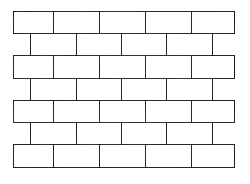 |
| Stretcher bond |
The thickness of the stretcher bond is not more
than half a brick wall.
Stretcher bonds of brick are used for the non load
bearing wall, cavity walls, partition wall etc.
English Bond
English bond – English bond is the most popular and easier
construction of brick bond compared to another type of brick bond. English bonds of
brick are used for each and every construction site. In this type of brick bond
one layer is a header and another layer a stretcher, it means alternative
layers of header and stretcher.
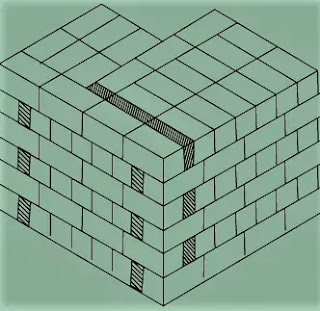 |
| English Bond |
The important thing about English brick bonds is each
header is Centrally supported to the alternate stretcher.
Flemish Bond
Flemish bond – In Flemish bond, each layer consists of alternation
of header and stretcher course. Flemish bond of brick alternate course
starts with a header at the corner, the merit’s of Flemish bond is broken
bricks can be used, but another consumption of a mortar will be high.
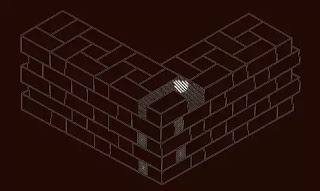 |
| Flemish Bond |
Type of Flemish brick Bond
Flemish Bond categorise between two parts –
- Single Flemish bond
- Double Flemish bond
Single Flemish Bond
Single Flemish bond – In this type of brick bond,
Face consists of Flemish bond and backing consists of English bond in each
course. It means single Flemish bond is the combination of Flemish bond and English bond. [Building Construction mcq]
In this type of brick Bond, The thickness of the
brick wall is not less than 1 1/2 bricks.
Double Flemish Bond
Double Flemish bond – In double Flemish bond, Each course presents the
same appearance backing and facing elevation.
In this type of brick bond, The thickness of the
brick wall is 2 bricks.
Dutch Bond
Dutch Bond – Dutch Bond is a modification of English bonds.
In this type of brick Bond, alternative courses of
header and stretcher and every stretcher start with a three – quarter brick,
and header courses are placed over the stretcher course.
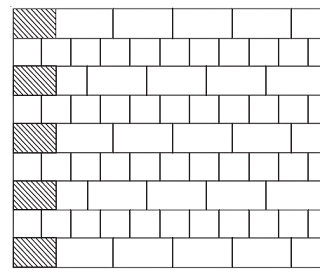 |
| Dutch Bond |
Garden wall Bond
Garden wall Bond – Garden wall bond categories between two types –
- English Garden wall
- Flemish Garden wall
English Garden wall bond
English Garden wall – In this type of
brick Bond, One course is a header and another every three to four courses are
arranged with the stretcher.
 |
| English garden wall bond |
Flemish Garden wall bond
Flemish Garden wall – In this type of brick Bond,
One course consists of Flemish bond but one header is used for every three or
four stretchers.
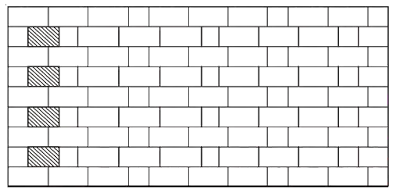 |
| Flemish garden wall bond |
Raking Bond
Raking Bond – The walls which are two brick thick or more thick
are weaker in longitudinal strength. Raking is a technique for removing the
weakness of longitudinal strength due to inclination of the wall.
Raking Bond are categorised between two different
brick bond –
- Herring Bond
- Diagonal Bond
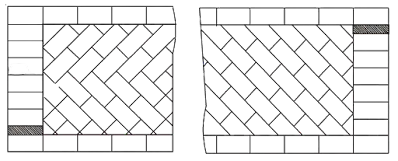 |
| Herring Bond – Diagonal Bond |
Facing Bond
Facing bond – This brick bond is used for the facing work. Facing
brick bonds are more costlier than the other type of brick bond.
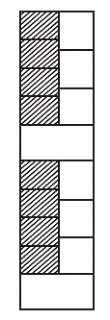 |
| Facing bond |
In facing brick bonds the thickness of face and
back brick are different.
FAQ’s
What is the strongest brick bond?
Answer – English bond is the most popular, easier and strongest construction of brick bond compared to another type of brick bond.
What are the types of brick bonds?
Answer – Eight types of brick bond
- Header bond
- Stretcher Bond
- English bond
- Flemish bond
- Dutch bond
- Garden wall bond
- Raking bond
- Facing bond
Is brick a size?
Answer – Standard or modular size of brick – 19 cm x 19 cm x 9 cm, Nominal size of brick – 20 cm x 20 cm x 10 cm, Traditional size of bricks – 23 cm x 11.4 cm x 7.6 cm.
How many brick are 1m3
Answer –Number of bricks 1 meter cube bricks masonry = 500 bricks, Number of bricks in 1 metre square volume = 500 bricks.
Chemical composition of good brick
earth?
Answer – Silica – 50% – 60%, Alumina – 20% to 30%, Lime – 4% to 6%, Magnesia – 1 %.
|| Civil Notebook ||


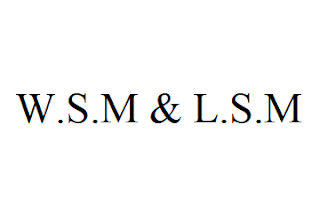
Pingback: Consistency of Soil | Stage | Consistency Limit | Liquid – Plastic – Solid – Shrinkage limit | Determination of limit – civilnotebook.com
Pingback: Cavity wall: Construction, Purpose, Advantages & disadvantages – civilnotebook – civilnotebook.com
Pingback: Chlorination | Type of chlorination | Residual Chlorine - civilnotebook.com
Pingback: Sedimentation | Principle | Type of sedimentation tank - civilnotebook.com
Pingback: 10 by 40 house plan | Submission drawing with estimate | PDF
In my opinion you commit an error. Let’s discuss it. Write to me in PM, we will communicate.
what? please explain
I apologise, but, in my opinion, you are not right. I am assured. I can defend the position. Write to me in PM, we will discuss.
ok